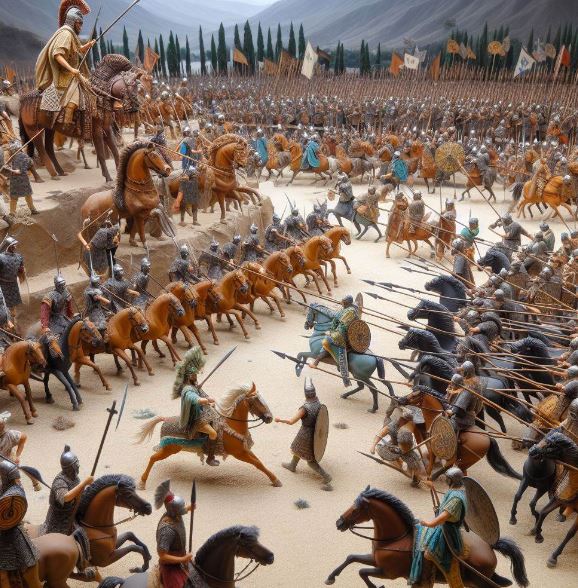The movie “The Patriot: The Fox of the Swamp” tells the story of colonial Americans, experienced in battling Native Americans, who form a militia unit and employ highly irregular tactics to strike at the British regulars. The protagonist, portrayed by Mel Gibson, is nicknamed “The Fox of the Swamp,” and demonstrates the essence of guerrilla warfare.
As the film approaches its climax, it returns to a scene reminiscent of ancient battle formations, where troops face each other in tight ranks and advance. This is not unlike the opening scene of the movie “Gladiator,” set in the Roman era, or the battles depicted in “Braveheart,” which portrays the 13th-century Scottish hero William Wallace. These battles lack tactical sophistication, filled only with the tragic futility of soldiers standing to be shot and the repulsion of war’s lethality. Such battles are mere games for generals, with soldiers as expendable as pieces in chess or Go. This formation was likely necessary at the time due to the short effective range and poor accuracy of the muskets.

The Patriot: more flag-waving rot with Mel Gibson | Period and historical films | The Guardian
However, as the accuracy and firepower of weapons improved, this type of combat disappeared. Defensive strategies became increasingly advantageous, leading to trench warfare, which became prevalent. Movies like “All Quiet on the Western Front,” set during World War I, frequently depict trench scenes—digging, conversing within, and attacking trenches. Trench warfare was a long and tedious affair. Indeed, the trenches built between France and Germany stretched for 1000 km, and it is said that advancing even a meter cost thousands of lives. The reckless charges of soldiers toward machine-gun firing trenches underscore this grim reality.
The advent of the tank marked a pivotal change. General Fuller of Britain, participating in World War I in France, believed that breaking through enemy lines was crucial for winning the war. Introduced to the tank in 1916, he became convinced of its utility for breakthrough tactics. By December 1916, Britain had formed its first tank unit, in which Fuller participated, leading to a victorious breakthrough at the Battle of Cambrai in 1917. Similarly, the strategic importance of tanks was recognized in Germany by General Heinz Wilhelm Guderian. Having experienced the effectiveness of tanks in World War I, Guderian prepared extensively before World War II, establishing several panzer divisions by 1939. Upon receiving orders from Hitler, he led his tank units to swiftly breach Poland’s main defense lines within four days, demonstrating the importance of thorough strategic preparation.

Business studies often emphasize competitiveness the most. However, the concept of competition is not an old phenomenon in business education. In times when anything produced was sold, internal management issues such as productivity were more crucial than competition. But now, no company can afford to disregard competition, which has become a strategic issue. The same applies to individuals. There was a time when one could secure a job by simply learning double-entry bookkeeping, and having a degree made one a guaranteed professor at a university. However, competition has now become so intense that we truly experience what is meant by ‘fierce competition.’ It has reached a point where countries, companies, and individuals must consider competitiveness.
So, what is competitiveness? It refers to tangible and intangible resources and capabilities that allow one to win in competition. It’s important to note that competitiveness is not determined alone; much like nature selects traits in organisms, the market selects the competitiveness of individuals and companies. This concept has led to the term ‘market selection,’ analogous to ‘natural selection.’ The market, meaning any space and time where competition exists, constantly changes. Therefore, true competitiveness must also frequently change according to time, location, and the competition.
There was a time when quality was a competitive advantage. Japanese companies excelled in this competitive landscape by producing superior products at lower costs with very low defect rates, conquering global markets. In the 1980s, Japanese firms capitalized on American foundational technologies to launch application products earlier, thereby enhancing their market dominance. However, companies from other countries learned from this and started to match the efficiency of Japanese companies. They all studied “best practices” and replicated these methods. Many companies became more efficient and began producing high-quality products. Michael Porter described this phenomenon as “competitive convergence.”
This competitive convergence led to challenges for many successful Japanese companies in the 1990s. They found it difficult to maintain a sustainable competitive advantage by merely making better and cheaper products. Being slightly superior was not enough to sustain a competitive edge.
Thus, in today’s business environment, core competencies have become essential for a company’s survival and growth. In business studies, core competencies are not just activities a company performs well; they are capabilities that provide a competitive advantage. C.K. Prahalad and Gary Hamel emphasized that core competencies must be able to create value, be distinctive, extendable, and impossible to replicate.
To discern whether something is a core competency, it should meet these four criteria. Let’s consider the core competencies of global companies: General Electric has made its ability to manage highly diversified business areas its core competency. In contrast, P&G has excelled in leading numerous successful brands. Coca-Cola’s core competency is its brand image, while for Walt Disney, it’s customer service, and for FedEx and Walmart, it’s their fast and efficient logistics systems. Honda is known for its engine technology, Toyota for its production efficiency, Sony for its miniaturization technology, and Canon for its precision mechanics and optics.
Thus, companies discover these core competencies and utilize them not just company-wide but also connect new technologies, products, and services to them to continue growing. Today’s competitiveness in business essentially means having such core competencies, which fundamentally signify differentiation. However, it’s not just any differentiation, but differentiation that the market desires.
From the perspective of business studies, differentiation means being distinct from competitors in a way that appeals to customers. Porter calls this a ‘strategic position.’ Strategy, ultimately, is about creating competitiveness through unique business activities that differentiate one from competitors.
Focus on core competencies:
Today’s competition requires distinct competitiveness in a specific field to emerge victorious. Having a comparative advantage is a process necessary for survival, but not sufficient to be competitive by itself. It’s not necessary to have an absolute advantage in all areas; having a competitive advantage emphasized in business studies is sufficient.
In a forest, the strongest animals dominate essential resources like water sources for survival. But in today’s reality, there are various sources, and if necessary, one can dig their own, provided it yields drinkable water — a source needed by the market.
The term ‘blue ocean’ refers to a market without competition. However, if there are no customers in that market, that blue ocean could turn into a deadly one, teeming with metaphorical sharks. This suggests that new and varied competitions exist, and blue ocean markets are created, implying different competitors and methods of competition.
In fact, in the same tournament, not all abilities need to be superior to win. For instance, golf involves driving, iron shots, short game, and putting. Tiger Woods, who dominated the PGA for years, does not have an absolute advantage in these four areas; in fact, he ranked 37th in putting in 2006. Tennis involves skills like serving, stroking, and volleying. Rafael Nadal, known as the ‘King of Clay,’ has won the French Open four times, mostly without volleying.


답글 남기기